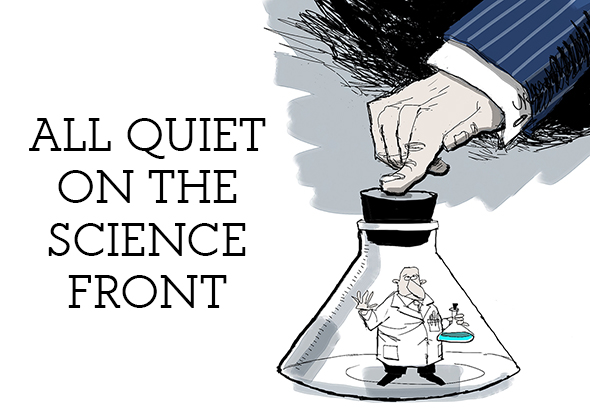Stop silencing our scientists! – Pt. 1
Written by: Nick G. on 24 March 2021
 The revelation, yesterday, that the NSW government had tried to change the work of a scientist preparing an Environmental Impact Statement (EIS) on a proposal to raise the height of Sydney’s Warragamba Dam will sadly come as no surprise to the scientific community.
The revelation, yesterday, that the NSW government had tried to change the work of a scientist preparing an Environmental Impact Statement (EIS) on a proposal to raise the height of Sydney’s Warragamba Dam will sadly come as no surprise to the scientific community.
Scientists, and particularly those working in areas like conservation and climate change,
have told researchers that they “self-censor information for fear of damaging their careers, losing funding or being misrepresented in the media (and that) senior managers or ministers’ officers prevented researchers from speaking truthfully on scientific matters.”
In the current extreme rainfall and flooding event over parts of NSW, Queensland and Victoria, the overflow of floodwaters from the Warragamba Dam has given some credibility to plans, first mooted some years ago, to raise the dam wall by at least 14 metres.
However, this has serious environmental and social implications:
• It could inundate over 4,700 hectares of the UNESCO World Heritage-listed Blue Mountains National Park and destroy the last wild river in Western Sydney, the Kowmung River.
•
The project would likely impact up to half of the remaining population of the
critically endangered regent honeyeater; and 28 species of threatened animals, including nine mammals. Regent honeyeaters are so rare that young birds aren't learning their own song.
The scientist preparing the EIS had estimated that the cost to NSW of compensation for environmental damage would be $2.88 billion, more than four times the initial estimate of the project cost, touted at $690 million.
What followed were attempts to force her to change key findings in the draft EIS.
She was pressured to change language about impacts on plants and animals from "will likely kill" to "may impact” and to change her categorisation of the damage expected to occur upstream of the dam — where the higher wall would flood ecosystems — from "direct" impacts of the project to “indirect” impacts.
Pressure on the scientist by the government is unlawful and corrupt. The law requires that an EIS be conducted by an independent assessor. Under unlawful pressure to change her findings, she quit.
She was immediately replaced by someone who, until then, had been working for the government on the dam-raising project at WaterNSW.
Harry Burkitt from the Colong Foundation for Wilderness said: "Why is someone who is trying to get an outcome for WaterNSW in raising Warragamba Dam wall, now being put in charge of determining the ecological impacts of this proposal?"
Professor of corporate governance at UTS Thomas Clarke said the revelations were shocking.
"A profound concern outlined here is that the NSW government is allowing the conditions to be created for a major ecological disaster to the ancient ecology of the Blue Mountains, and has allowed a systemic undermining of governance processes to enable this including a serious neglect of its own code of conduct concerning objective advice and conflicts of interest," he said.
"This apparent manipulation of results to suit NSW agency interests is directly contradicting the principles of NSW regulation."
The silencing of scientists like the ecologist in this example, is seriously undermining the community’s right to know.
It is indicative of how policy-making under capitalism too often treats the public as mushrooms – kept in the dark and fed bullshit.
In a second article, we will examine further examples of this ugly phenomenon.
Print Version - new window Email article
-----
Go back
 The revelation, yesterday, that the NSW government had tried to change the work of a scientist preparing an Environmental Impact Statement (EIS) on a proposal to raise the height of Sydney’s Warragamba Dam will sadly come as no surprise to the scientific community.
The revelation, yesterday, that the NSW government had tried to change the work of a scientist preparing an Environmental Impact Statement (EIS) on a proposal to raise the height of Sydney’s Warragamba Dam will sadly come as no surprise to the scientific community.